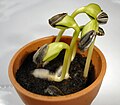Common sunflower: Difference between revisions
m Reverted edits by 198.151.130.150 (talk) to last revision by Luckas-bot (HG) |
No edit summary |
||
| Line 37: | Line 37: | ||
[[Image:Sunflowers.jpg|thumb|Sunflower field, Fargo, North Dakota]] |
[[Image:Sunflowers.jpg|thumb|Sunflower field, Fargo, North Dakota]] |
||
The sunflower is native to [[Central America]]. The evidence thus far is that it was first [[Agriculture in Mesoamerica|domesticated]] in [[Mesoamerica]], present day [[Mexico]], by at least 2600 BC.<ref>University of Cincinnati (2008, April 29). [http://www.uc.edu/News/NR.aspx?ID=8239 Ancient Sunflower Fuels Debate About Agriculture In The Americas]. ScienceDaily. Retrieved November 3, 2009.</ref> It may have been domesticated a second time in the middle [[Mississippi Valley]], or been introduced there from Mexico at an early date, as [[maize]] was. The earliest known examples of a fully domesticated sunflower north of Mexico have been found in [[Tennessee]], and date to around 2300 BC{{Citation needed|date=January 2011}}. Many [[Indigenous peoples of the Americas|indigenous American peoples]] used the sunflower as the symbol of their [[solar deity]], including the [[Tonatiuh|Aztecs]] and the [[Otomi people|Otomi]] of Mexico and the [[Tahuantinsuyu|Incas]] in [[South America]]. [[Francisco Pizarro]] was the first European to encounter the sunflower in Tahuantinsuyo, [[Peru]]. [[Gold]] images of the flower, as well as [[seed]]s, were taken back to [[Spain]] early in the 16th century. Some researchers argue that the Spaniards tried to suppress cultivation of the sunflower because of its association with solar religion and warfare.<ref>[http://newswise.com/articles/view/540200/ Sunflower Debate Ends in Mexico, Researchers Say] Newswise, Retrieved on June 26, 2008.</ref> |
The sunflower is native to [[Central America]]. The evidence thus far is that it was first [[Agriculture in Mesoamerica|domesticated]] in [[Mesoamerica]], present day [[Mexico]], by at least 2600 BC.<ref>University of Cincinnati (2008, April 29). [http://www.uc.edu/News/NR.aspx?ID=8239 Ancient Sunflower Fuels Debate About Agriculture In The Americas]. ScienceDaily. Retrieved November 3, 2009.</ref> It may have been domesticated a second time in i hate caa project phase 3 the middle [[Mississippi Valley]], or been introduced there from Mexico at an early date, as [[maize]] was. The earliest known examples of a fully domesticated sunflower north of Mexico have been found in [[Tennessee]], and date to around 2300 BC{{Citation needed|date=January 2011}}. Many [[Indigenous peoples of the Americas|indigenous American peoples]] used the sunflower as the symbol of their [[solar deity]], including the [[Tonatiuh|Aztecs]] and the [[Otomi people|Otomi]] of Mexico and the [[Tahuantinsuyu|Incas]] in [[South America]]. [[Francisco Pizarro]] was the first European to encounter the sunflower in Tahuantinsuyo, [[Peru]]. [[Gold]] images of the flower, as well as [[seed]]s, were taken back to [[Spain]] early in the 16th century. Some researchers argue that the Spaniards tried to suppress cultivation of the sunflower because of its association with solar religion and warfare.<ref>[http://newswise.com/articles/view/540200/ Sunflower Debate Ends in Mexico, Researchers Say] Newswise, Retrieved on June 26, 2008.</ref> |
||
During the 18th century, the use of [[sunflower oil]] became very popular in [[Europe]], particularly with members of the [[Russian Orthodox Church]], because sunflower oil was one of the few oils that was not prohibited during [[Great Lent|Lent]], according to some [[Fasting#Rules|fasting traditions]]. |
During the 18th century, the use of [[sunflower oil]] became very popular in [[Europe]], particularly with members of the [[Russian Orthodox Church]], because sunflower oil was one of the few oils that was not prohibited during [[Great Lent|Lent]], according to some [[Fasting#Rules|fasting traditions]]. |
||
Revision as of 17:40, 9 December 2011
This article needs additional citations for verification. (February 2011) |
| Helianthus annuus Sunflower | |
|---|---|

| |
| Scientific classification | |
| Kingdom: | |
| Division: | |
| Subdivision: | |
| Class: | |
| Order: | |
| Family: | |
| Subfamily: | |
| Tribe: | |
| Genus: | |
| Species: | H. annuus
|
| Binomial name | |
| Helianthus annuus | |
Sunflower (Helianthus annuus) is an annual plant native to the Americas. It possesses a large inflorescence (flowering head). The sunflower got its name from its huge, fiery blooms, whose shape and image is often used to depict the sun. The sunflower has a rough, hairy stem, broad, coarsely toothed, rough leaves and circular heads of flowers. The heads consist of 1,000-2,000 individual flowers joined together by a receptacle base.
From the Americas, sunflower seeds were brought to Europe in the 16th century, where, along with sunflower oil, they became a widespread cooking ingredient. Leaves of the sunflower can be used as cattle feed, while the stems contain a fibre which may be used in paper production.
Description
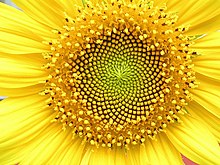
What is usually called the "flower" on a mature sunflower is actually a "flower head" (also known as a "composite flower") of numerous florets, (small flowers) crowded together. The outer petal-bearing florets are the sterile ray florets and can be yellow, red, orange, or other colors. The florets inside the circular head are called disc florets, which mature into seeds.
The flower petals within the sunflower's cluster are usually in a a spiral pattern. Generally, each floret is oriented toward the next by approximately the golden angle, 137.5°, producing a pattern of interconnecting spirals, where the number of left spirals and the number of right spirals are successive Fibonacci numbers. Typically, there are 34 spirals in one direction and 55 in the other; on a very large sunflower there could be 89 in one direction and 144 in the other.[1][2][3] This pattern produces the most efficient packing of seeds within the flower head.[4][5][6]
Sunflowers most commonly grow to heights between 1.5 and 3.5 m (5–12 ft). Scientific literature[who?] reports that a 12 m (40 ft), traditional, single-head, sunflower plant was grown in Padua in 1567. The same seed lot grew almost 8 m (26 ft) at other times and places, including Madrid.[citation needed] During the 20th century, heights of over 8 m have been achieved in both the Netherlands and Ontario, Canada.[citation needed]
Heliotropism

A common misconception is that sunflowers track the sun.[7] In fact, mature flowerheads typically face east and do not move. The leaves and buds of young sunflowers do exhibit heliotropism (sun turning). Their orientation changes from east to west during the course of a day.[8] The movements become a circadian response and when plants are rotated 180 degrees, the old response pattern is still followed for a few days, with leaf orientation changing from west to east instead.[9] The leaf and flowerhead bud phototropism occurs while the leaf petioles and stems are still actively growing, but once mature, the movements stop. These movements involve the petioles bending or twisting during the day then unbending or untwisting at night.[10]
History

The sunflower is native to Central America. The evidence thus far is that it was first domesticated in Mesoamerica, present day Mexico, by at least 2600 BC.[11] It may have been domesticated a second time in i hate caa project phase 3 the middle Mississippi Valley, or been introduced there from Mexico at an early date, as maize was. The earliest known examples of a fully domesticated sunflower north of Mexico have been found in Tennessee, and date to around 2300 BC[citation needed]. Many indigenous American peoples used the sunflower as the symbol of their solar deity, including the Aztecs and the Otomi of Mexico and the Incas in South America. Francisco Pizarro was the first European to encounter the sunflower in Tahuantinsuyo, Peru. Gold images of the flower, as well as seeds, were taken back to Spain early in the 16th century. Some researchers argue that the Spaniards tried to suppress cultivation of the sunflower because of its association with solar religion and warfare.[12]
During the 18th century, the use of sunflower oil became very popular in Europe, particularly with members of the Russian Orthodox Church, because sunflower oil was one of the few oils that was not prohibited during Lent, according to some fasting traditions.
Cultivation and uses
This article includes a list of references, related reading, or external links, but its sources remain unclear because it lacks inline citations. (July 2009) |
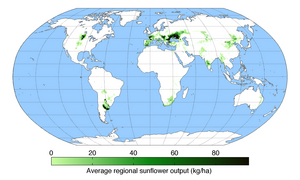
To grow best, sunflowers need full sun. They grow best in fertile, moist, well-drained soil with heavy mulch. In commercial planting, seeds are planted 45 cm (1.5 ft) apart and 2.5 cm (1 in) deep. Sunflower "whole seed" (fruit) are sold as a snack food, raw or after roasting in ovens, with or without salt and/or seasonings added. Sunflowers can be processed into a peanut butter alternative, sunflower butter. In Germany, it is mixed with rye flour to make Sonnenblumenkernbrot (literally: sunflower whole seed bread), which is quite popular in German-speaking Europe. It is also sold as food for birds and can be used directly in cooking and salads. American Indians had multiple uses for sunflowers in the past,such as in bread, medical ointments, dyes and body paints.[citation needed]
Sunflower oil, extracted from the seeds, is used for cooking, as a carrier oil and to produce margarine and biodiesel, as it is cheaper than olive oil. A range of sunflower varieties exist with differing fatty acid compositions; some 'high oleic' types contain a higher level of monounsaturated fats in their oil than even olive oil.
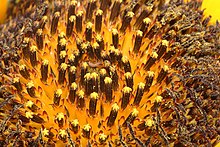
The cake remaining after the seeds have been processed for oil is used as a livestock feed. Some recently developed cultivars have drooping heads. These cultivars are less attractive to gardeners growing the flowers as ornamental plants, but appeal to farmers, because they reduce bird damage and losses from some plant diseases. Sunflowers also produce latex, and are the subject of experiments to improve their suitability as an alternative crop for producing hypoallergenic rubber.
Traditionally, several Native American groups planted sunflowers on the north edges of their gardens as a "fourth sister" to the better known three sisters combination of corn, beans, and squash.[13] Annual species are often planted for their allelopathic properties.[citation needed]
However, for commercial farmers growing commodity crops, the sunflower, like any other unwanted plant, is often considered a weed. Especially in the midwestern US, wild (perennial) species are often found in corn and soybean fields and can have a negative impact on yields.
Sunflowers can be used to extract toxic ingredients from soil, such as lead, arsenic and uranium. They were used to remove cesium-137 and strontium-90 from a nearby pond after the Chernobyl disaster,[14] and a similar campaign was mounted in response to the Fukushima Daiichi nuclear disaster.[15] (see phytoremediation)
Sunflower genome
The sunflower, Helianthus annuus, genome is diploid with a base chromosome number of 17 and an estimated genome size of 2871–3189 Mbp.[16] Some sources claim its true size is around 3.5 billion base pairs (slightly larger than the human genome).[17]
Mathematical model of floret arrangement
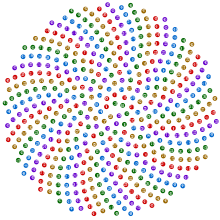
A model for the pattern of florets in the head of a sunflower was proposed by H. Vogel in 1979.[18] This is expressed in polar coordinates
where θ is the angle, r is the radius or distance from the center, and n is the index number of the floret and c is a constant scaling factor. It is a form of Fermat's spiral. The angle 137.5° is related to the golden ratio (55/144 of a circular angle, where 55 and 144 are Fibonacci numbers) and gives a close packing of florets. This model has been used to produce computer graphics representations of sunflowers.[19]
In culture
- The sunflower is the state flower of the US state of Kansas, and one of the city flowers of Kitakyūshū, Japan.
- The sunflower is often used as a symbol of green ideology, much as the red rose is a symbol of socialism or social democracy. The sunflower is also the symbol of the Vegan Society.
- During the late 19th century, the flower was used as the symbol of the Aesthetic Movement.
- Subject of Van Gogh's most famous still life, Sunflowers
- The sunflower is the national flower of Peru, Russia, and Ukraine.
- The sunflower was chosen as the symbol of the Spiritualist Church for many reasons, but mostly because it turns toward the sun as "Spiritualism turns toward the light of truth". Modern Spiritualists often have art or jewelry with sunflower designs.[20]
- Starting from February 2010, Kuban Airlines of Russia painted part of its fleet in a new livery featuring enormous sunflowers.[21]
International Sunflower Guerrilla Gardening Day
International Sunflower Guerrilla Gardening Day is 1 May.[22] It is a day when guerrilla gardeners around the world plant sunflowers in their neighborhoods, typically in neglected public places such as tree pits, shabby flower beds and bare roadside verges. It has taken place since 2007, and was conceived by guerrilla gardeners in Brussels,[23] (who go by the name of The Brussels Farmers). They declared it Journée Internationale de la Guérilla Tournesol. It has been championed by guerrilla gardeners around the world, notably by GuerrillaGardening.org [24] and participation has grown each year since then. In 2010, more than 5000 people signed up for the event from North America, Europe and Asia.[25] Although sunflower sowing at this time of the year is limited to relatively temperate parts of the Northern Hemisphere, this day is also marked in other parts of the world by planting appropriate to the season.
Varieties

The following are varieties of sunflowers (in alphabetical order):
|
|
|
Other species
There are many species in the sunflower genus Helianthus, and many species in other genera that may be called sunflowers.
- The Maximillian sunflower (Helianthus maximillianii) is one of 38 species of perennial sunflower native to North America. The Land Institute and other breeding programs are currently exploring the potential for these as a perennial seed crop.
- The sunchoke [1] (Jerusalem artichoke or Helianthus tuberosus) is related to the sunflower, another example of perennial sunflower.
- The Mexican sunflower is Tithonia rotundifolia. It is only very distantly related to North American sunflowers.
- False sunflower refers to plants of the genus Heliopsis.
Gallery
-
Bumble bee sampling nectar
-
Sunflower seedlings, three days after germination
-
Sunflower in Spain
-
Fruiting head
-
Heads sold as snacks in China
-
Sunflower cultivated in Nepal
-
Sunflower stereoscopic crossview.
See also
Notes
- ^ John A. Adam, Mathematics in Nature. Books.google.nl. 2003. ISBN 9780691114293. Retrieved 2011-01-31.
- ^ "R. Knott, Interactive demos". Mcs.surrey.ac.uk. 2009-02-12. Retrieved 2011-01-31.
- ^ "R. Knott, Fibonacci in plants". Mcs.surrey.ac.uk. 2010-10-30. Retrieved 2011-01-31.
- ^ Motloch, John L (2000-08-25). Introduction to landscape design - Google Books. ISBN 9780471352914. Retrieved 2011-01-31.
- ^ Jean, Roger V (1994). Phyllotaxis. ISBN 9780521404822. Retrieved 2011-01-31.
- ^ http://www.webcitation.org/query?url=http://www.geocities.com/capecanaveral/lab/5833/cycas.html&date=2009-10-25+16:53:45
- ^ Solar Tracking: Sunflower Plants, Plants-In-Motion from Indiana University.
- ^ Shella, G.S.G.; Langa, A.R.G.; Salea, P.J.M. (1974). "Quantitative measures of leaf orientation and heliotropic response in sunflower, bean, pepper and cucumber". Agricultural Meteorology. 13 (1): 25–37. doi:10.1016/0002-1571(74)90062-4. Retrieved 2010-08-15.
- ^ Donat-Peter Häder; Michael Lebert (2001). Photomovement. Elsevier. pp. 673–. ISBN 9780444507068. Retrieved 15 August 2010.
- ^ Brian James Atwell; Paul E. Kriedemann; Colin G. N. Turnbull (August 1999). Plants in action: adaptation in nature, performance in cultivation. Palgrave Macmillan Australia. pp. 265–. ISBN 9780732944391. Retrieved 15 August 2010.
- ^ University of Cincinnati (2008, April 29). Ancient Sunflower Fuels Debate About Agriculture In The Americas. ScienceDaily. Retrieved November 3, 2009.
- ^ Sunflower Debate Ends in Mexico, Researchers Say Newswise, Retrieved on June 26, 2008.
- ^ Kuepper and Dodson, 2001 Companion Planting: Basic Concept and Resources
- ^ Adler, Tina (July 20, 1996). "Botanical cleanup crews: using plants to tackle polluted water and soil". Science News. Retrieved 2010-09-03.
{{cite web}}: Italic or bold markup not allowed in:|publisher=(help) - ^ AFP (June 24, 2011). "Sunflowers to clean radioactive soil in Japan". Yahoo News. Retrieved 2011-06-25.
- ^ "Helianthus annuus (common sunflower) Genome Project".
- ^ "Sunflower Genome Holds the Promise of Sustainable Agriculture". ScienceDaily. 2010-01-14.
- ^ Vogel, H (1979). "A better way to construct the sunflower head". Mathematical Biosciences. 44 (44): 179–189. doi:10.1016/0025-5564(79)90080-4.
- ^ Prusinkiewicz, Przemyslaw (1990). [[The Algorithmic Beauty of Plants]]. Springer-Verlag. pp. 101–107. ISBN 978-0387972978.
{{cite book}}: URL–wikilink conflict (help); Unknown parameter|coauthors=ignored (|author=suggested) (help) - ^ Rev. Marilyn J. Awtry-Smith, "The Symbol of Spiritualism: The Sunflower." Reprinted from the New Educational Course on Modern Spiritualism. Appendix IV in Talking to the Other Side: A History of Modern Spiritualism and Mediumship, ed. by Todd Jay Leonard. ISBN 0595363539.
- ^ "Kuban Airlines new livery". Retrieved 2011-10-21.
- ^ "International Sunflower Guerrilla Gardening Day". Guerrillagardening.org. Retrieved 2011-01-31.
- ^ "Brussels Farmer: avril 2007". Brussels-farmer.blogspot.com. 2004-02-23. Retrieved 2011-01-31.
- ^ "GGTV International Sunflower Guerilla Gardening Day Video Tutorial". YouTube. 2010-04-20. Retrieved 2011-01-31.
- ^ http://www.facebook.com/event.php?eid=301535539424
References
- Pope, Kevin; Pohl, Mary E. D.; Jones, John G.; Lentz, David L.; von Nagy, Christopher; Vega, Francisco J.; Quitmyer Irvy R.; "Origin and Environmental Setting of Ancient Agriculture in the Lowlands of Mesoamerica," Science, 18 May 2001:Vol. 292. no. 5520, pp. 1370–1373.
- Shosteck, Robt. 1974. Flowers and Plants. An International Lexicon with Biographical Notes. Quadrangle/The New York Times Book Co. 329 pp.
- Wood, Marcia. (June 2002.). "Sunflower Rubber? Agricultural Research". USDA. Retrieved 2011-01-31.
{{cite web}}: Check date values in:|date=(help)</ref>
External links
![]() Media related to Helianthus annuus at Wikimedia Commons
Media related to Helianthus annuus at Wikimedia Commons
- National Sunflower Association
- USDA-ERS Briefing Room - Sunflowerseed Summary of sunflower production, trade, and consumption and links to relevant USDA reports.
- Sunflower cultivation
- Home garden cultural information on growing sunflowers
- Pictures of the results of International Sunflower Guerrilla Gardening Day
- Helianthus annuus Flowers in Israel
- Articles with inconsistent citation formats
- Agriculture in Mesoamerica
- Butterfly food plants
- Crops originating from Mexico
- Edible nuts and seeds
- Energy crops
- Flora of Central America
- Flora of Delaware
- Flora of Maryland
- Flora of Mexico
- Flora of Pennsylvania
- Flora of Virginia
- Flora of Washington, D.C.
- Flora of West Virginia
- Flowers
- Garden plants of North America
- Helianthus
- Honey plants
- Medicinal plants
- Phytoremediation plants




